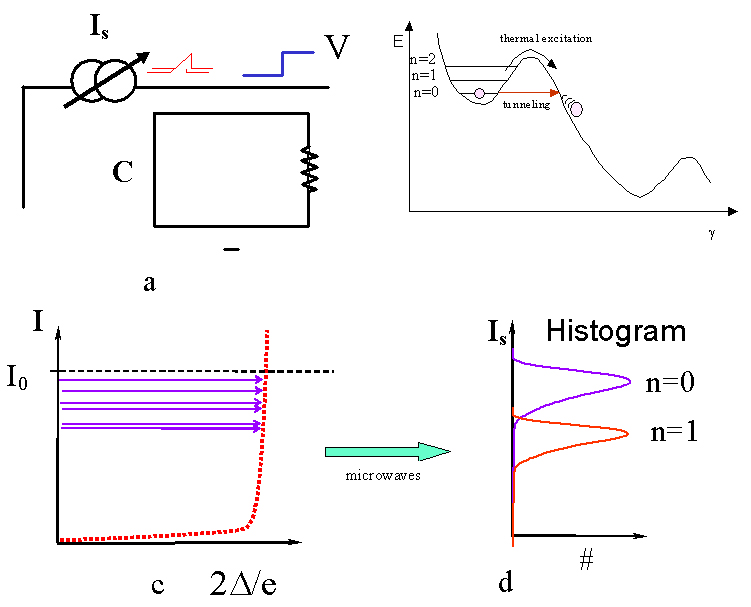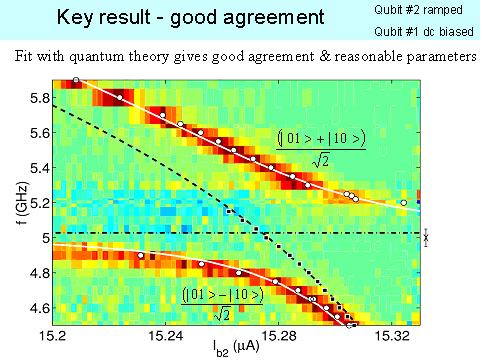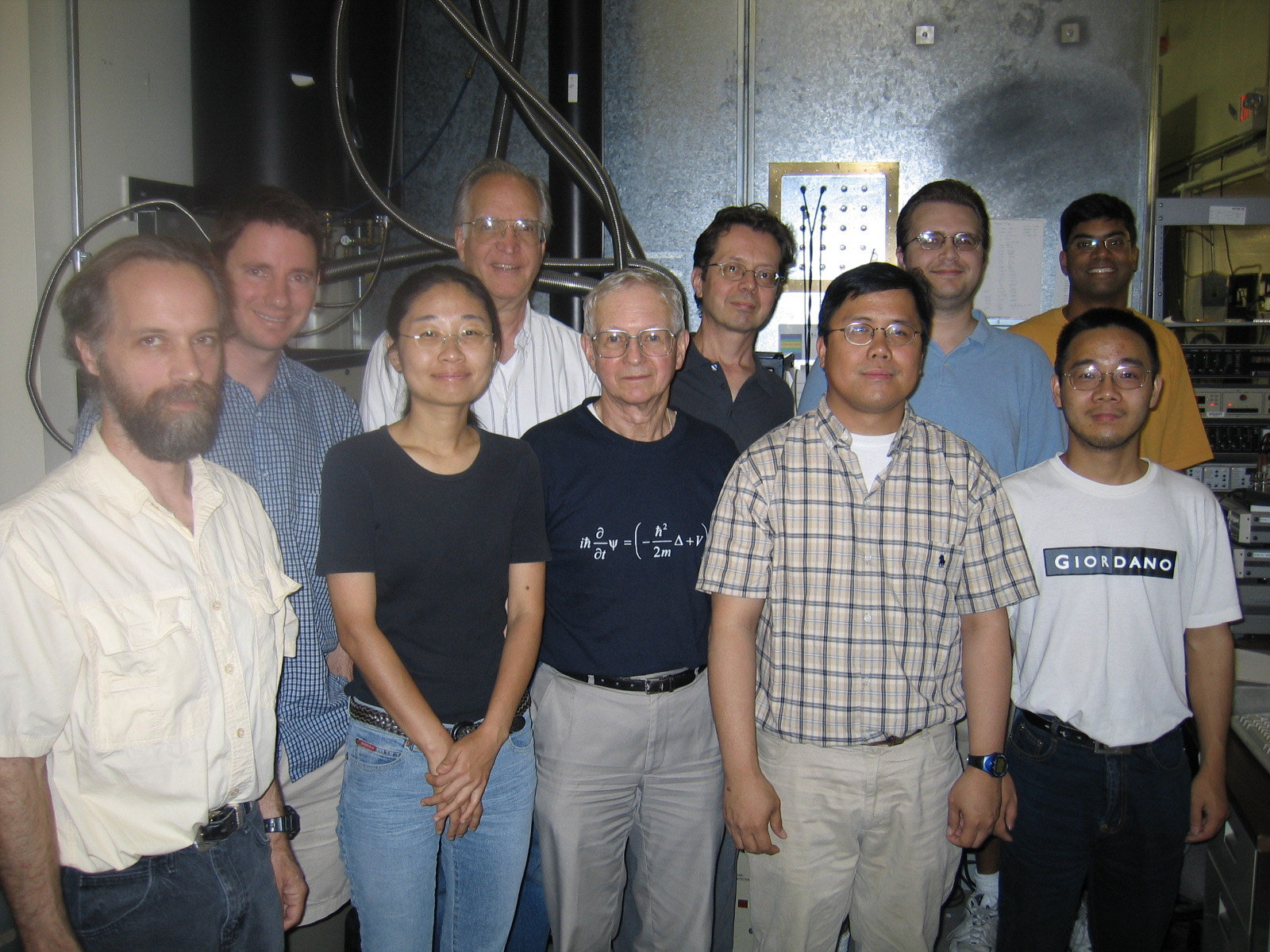|
Josephson-Junction
Qubits: Entanglement and Coherence
By J. Robert Anderson
Since our previous article, "Quantum
Computing with rf SQUIDs", which appeared about four years ago in
The Photon, we have made changes in our primary approach to the use of
superconducting elements as qubits. Now we are focusing on single Josephson
junctions as qubits, an idea that was suggested by members of our research
group.(1)
The qubit (quantum bit) of a quantum computer differs from the classical
bit of an ordinary computer; the bit of an ordinary computer is in one
of two states, 0 or 1, while a qubit can be in an arbitrary superposition
state of both 0 and 1. When N qubits interact, they can become an entangled
superposition of all 2N classical possibilities. This exponential increase
of possibilities provides the fundamental power of a quantum computer.
The enemy of the qubits of a quantum system is interaction with the environment,
which leads to decoherence and destroys the coherent superposition states.
Producing qubits with long coherence times is an important goal on the
way to a quantum computer.
The single-junction qubit has both advantages and disadvantages when compared
with the rf SQUID, which includes a current loop. The junctions themselves,
which are typically of micrometer dimensions, are much less sensitive
to decoherence sources such as magnetic flux and charge noise. In addition,
the junction properties, such as the critical current and phase difference
across the barrier, can be controlled rather easily by the bias current
and an applied magnetic field. The main disadvantage is that, because
of the current bias lines, the junctions are very sensitive to current
noise and these lines must be filtered well to block extraneous signals.
Since the field of superconductivity has a long history in developing
junction arrays, we do not expect scalability up to a large number of
single-junction or rf-SQUID qubits to be a limiting factor in this program.
Fig. 1a shows schematically the junction configuration with its bias current
and parallel capacitance and resistance. Such a single-junction qubit
uses metastable energy levels in the so-called "washboard potential" to form the 0 and 1 states and their combinations. This potential, tilted
in the presence of a bias current, depends on the phase difference of
the wave functions across the junction (see Fig. 1b). At typical experimental
conditions, the separation of the energy levels is small compared to the
energy corresponding to room temperature. For this reason our experiments
must be carried out at milli-Kelvin temperatures in a dilution refrigerator.
The behavior of the current-biased junction and the "escape"
to the voltage state are analogous to a ball, perhaps we should call it
a "phase-ball", rolling in a landscape like a tilted washboard.
With zero or small bias currents the ball has only a little kinetic energy
and oscillates in a valley of the washboard. That is, the state of the
junction remains in the metastable level of the potential well, corresponding
to the zero-dc-voltage condition as shown in Fig. 1b. As the bias current
increases the potential barrier decreases and it becomes possible for
the ball to leave one potential well and roll continuously down hill.
This corresponds to the "escape" for the junction, thereby producing
a measurable voltage. The appearance of this voltage is the signature
of escape, and can be related to the value of the bias current at which
this escape occurs. This voltage could constitute the readout of the status
of the junction for a quantum computer.
In Fig. 1c we show the current-voltage (I-V) characteristics of a junction.
Starting at zero, the current can be increased up to or near the limiting
value, i.e. the critical current I0. At some current less than I0 the
junction will switch to the voltage state and the value of the current
at which this switching or "escape" takes place can be recorded.
For our initial experiments on single junctions we ramped the bias current
and noted the value of the current at which escape occurred. We repeated
this experiment many times and obtained a histogram of switching events,
bias current vs. number of escapes.
Using this technique at slow ramping rates and at different temperatures,
we have been able to estimate the relaxation time of these qubits. This
appears to be a useful and simple method for establishing an upper bound
on the coherence times of our qubits and systems of qubits and allows
us to test quickly different schemes for isolating our qubits from the
environment.(2)
Next we applied a microwave signal in addition to the ramped bias current
and studied the influence of the microwave signal on the escape rate.
This is a form of microwave spectroscopy, called energy level spectroscopy,
and is similar to optical absorption spectroscopy, which is used to study
transitions between energy levels in atoms. The microwave signal at frequencies
of the order of a few GHz produces an enhancement of the escape rate corresponding
to the separation of energy levels in the washboard potential. This separation
decreases with increasing bias current. Fig. 1d shows schematically a
histogram of the bias current vs. the increased number of events due to
the presence of microwaves of fixed frequency. That is, n=0 represents
the enhancement due to microwave induced transitions from the n = 0 level
to the next level, n = 1; n = 1 represents the transition from the n =
1 level to the next higher level, n = 2 Note that higher bias currents
are required to produce escape from the lower level. In this manner we
have mapped out the dependence of the energy levels on the bias current.
Xu et al. have carried out calculations to simulate the resonant activation
that we have observed in our current-biased junctions.(3)
Recently we have coupled two of these junction qubits with a capacitor
and carried out energy level spectroscopy on this system. Since we are
able to bias each junction separately and to control the coupling between
the junctions with these bias currents, we are able to study the energy
levels as a function of the amount of this coupling. We observed an avoided
crossing of the energy levels as shown in Fig. 2.(4) Such an avoided crossing
would not be expected if the junctions were uncoupled. This avoided level
crossing agrees quantitatively with a quantum mechanical model of the
experimental circuit including the junctions. This model, first explored
by our group in a theoretical study, shows that the excited energy levels
are maximally entangled when the bias currents are approximately the same.(5)
We believe that this is evidence for quantum entanglement of the two junctions,
which is surprising since a macroscopic distance of nearly a millimeter
separates the junctions. The research has been published4 and was described
by Dr. Andrew Berkley in his thesis.(6)
In order to use phase states of Josephson junctions as qubits, the coherence
times of these interacting "entangled" junctions must be much
longer than the times required to perform gate operations such as Controlled
Phase, SWAP, or CNOT (also referred to as an exclusive OR). (The Controlled
Phase gate in its simplest form leaves the control bit unchanged and changes
the sign of the target bit. The SWAP gate swaps the values of the two
qubits while the CNOT leaves the control qubit unchanged and switches
the state of the target qubit only if the control qubit is in the 1 state.)
At the present time the coherence times are much too short, of the order
of nanoseconds, and we must provide better isolation for our junctions.
We are experimenting with different schemes for filtering the current
bias and microwave lines by means of resistance, capacitance, and inductance
combinations, metal-powder filters, and active filters composed of superconducting
elements. For these configurations we have been studying the escape rates
of single and coupled junctions and from these measurements we have extracted
correlation times. Fig. 3 shows an example of these escape rates as a
function of current bias both with and without the addition of microwaves.
One of our more immediate experimental goals is to increase coherence
times so as to demonstrate Rabi oscillations (the reversible evolution
of a qubit between 0 and 1 states correlated with the emission and absorption
of a microwave photon) in single and coupled qubits.
Theoretical studies of coupling, switching, and gate operations by members
of our group are used to guide the experimental program. We have published
the first detailed calculations for the operation of the SWAP and controlled-phase
gates based on our Josephson-junction representation of qubits.7 Aided
by such theoretical simulations and model calculations we plan to investigate
the coupling of more than two qubits and incorporate additional qubits
for error correction. A succeeding step will be to demonstrate simple
gate operations. These are not simple goals.
At the present time the members of our quantum computing group include
four faculty members, Fred Wellstood (PI), Chris Lobb, Alex Dragt and
Robert Anderson, post-docs Phil Johnson and Roberto Ramos, graduate students
Sudeep Dutta, Hanhee Paik, Fred Strauch, and Huizhong Xu, and undergraduate
students Bill Parsons and Mohamed Abutaleb. Andrew Berkley received his
Ph.D. last August and is now at D-Wave Systems Inc. in Vancouver, Canada.
Bill Parsons graduated and is now in a Masters Program in Applied Physics
at Johns Hopkins University. The figure below shows members of our group "posing" near the screen room of our larger dilution refrigerator.
Figure 1. a) Schematic of the current-biased
junction X, with junction capacitance C and resistance R in parallel.1
b) Schematic of the tilted washboard potential E vs. phase difference
. Metastable levels 0, 1, and 2 are shown in one of the wells. c) I vs.
V for the current-biased junction showing the critical current I0 and
switching events. The arrows show the hysteresis in the I-V characteristics.
d) Histogram of the number of switching events vs. bias current in the
presence of a microwave signal at fixed frequency.
 |
Figure 2. Microwave spectroscopy,
i.e. microwave absorption frequency vs. bias current through junction
2, for two junctions, coupled and uncoupled. The dot-dash line shows the
results for an uncoupled junction 1 at fixed bias current Ib1. The black
squares represent data points for uncoupled junction 2 and the dashed
line is a theoretical fit. The white circles show data corresponding to
microwave excitation to the second and third energy levels of the coupled
junctions as a function of the bias current through junction 2 with the
constant bias current through junction 1. The colors represent the amount
of microwave enhancement of the escape rates with red being the highest
and blue the lowest. The white lines are theoretical fits.
 |
Figure 3. Escape rates at a base temperature
of 25 mK as a function of bias current. without and with application of
microwave power. The microwave frequency is 5.5 GHz. Small peaks, which
correspond to enhanced escape by microwave excitation from level 0 to
level 1 and from level 1 to level 2, are shown by the green data points.
Figure 4. Members of the QC group
in front of the screen room. From left to right: Front row - Fred Wellstood,
Hanhee Paik, Robert Anderson, Roberto Ramos, and Huizhong Xu; Back row
- Phil Johnson, Alex Dragt, Chris Lobb, Fred Strauch, and Sudeep Dutta.
 |
1 R. C. Ramos, M. A. Gubrud, A. J. Berkley, J. R. Anderson,
C. J. Lobb, and F. C. Wellstood, " Design for Effective Thermalization
of Junctions for Quantum Coherence", IEEE Trans. Appl. Supercond.
11, 998 (2001).
2 S. K. Dutta, H. Xu, A. J. Berkley, R. C. Ramos, M. A. Gubrud, J. R.
Anderson, C. J. Lobb, and F. C. Wellstood, " Determination of Relaxation
Time of a Josephson Junction Qubit", Submitted to Phys. Rev. B (Rapid
Communications).
3 H. Xu, A. J. Berkley, M. Gubrud, R. Ramos, J. R. Anderson, C. J. Lobb,
F. C. Wellstood, "Analysis of Energy Level Quantization and Tunneling
from the Zero-Voltage State of a Current-Biased Josephson Junction," IEEE Trans. Appl. Supr. 13, 956 (2003).
4 A. J. Berkley, H. Xu, M. Gubrud, R. Ramos, F. W. Strauch, P. R. Johnson,
J. R. Anderson, A. J. Dragt, C. J. Lobb, and F. C. Wellstood, "Entangled
Macroscopic Quantum States in Two Superconducting Qubits", Science
300, 1548 (2003).
5 P. R. Johnson, F. W. Strauch, A. J. Dragt, R. C. Ramos, C. J. Lobb,
J. R. Anderson, and F. C. Wellstood, "Spectroscopy of Capacitively
Coupled Josephson-Junction Qubits", Phys. Rev. B 67, 020509 (Rapid
Communications) (2003).
6 Andrew J. Berkley, "A Josephson Junction Qubit", Ph. D. Thesis
(2003).
7 F. W. Strauch, P. R. Johnson, A. J. Dragt, C. J. Lobb, J. R. Anderson,
and F. C. Wellstood, "Quantum Logic Gates for Coupled Superconducting
Phase Qubits", Phys. Rev. Lett. 91, 167005 (2003).
Dr. J. Robert Anderson is a
full professor working in the field of experimental condensed matter physics
here in the Department of Physics at the University of Maryland. If you
have any questions, he can be reached at ja26@umail.umd.edu. |



